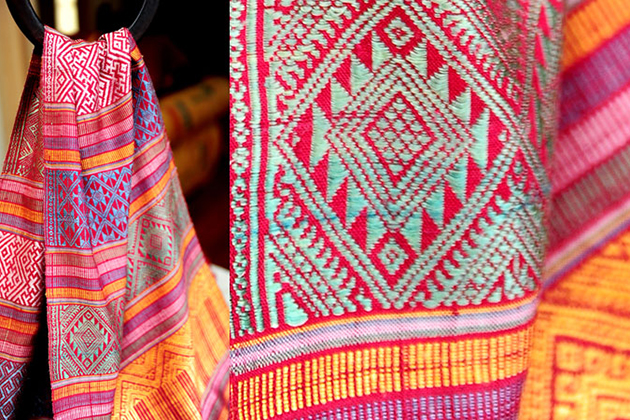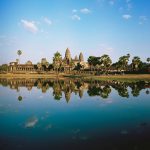Embracing Tradition: The Timeless Elegance of Lao Traditional Clothing (Sinh)
Nestled in the heart of Southeast Asia, Laos, a country known for its stunning landscapes and rich cultural heritage, has a vibrant tradition of clothing that reflects its history, diversity, and the spirit of its people. At the core of Lao traditional attire is the “Sinh,” a garment that embodies the essence of Laotian culture. In this travel article by Green Sun Travel, we invite you to explore the world of the Lao traditional clothing (sinh) and discover how it weaves a story of heritage, elegance, and artistry.
What to know about Lao traditional clothing (sinh)
A Glimpse into Lao Culture:

Lao culture is a tapestry that weaves together the multifaceted influences of history, spirituality, and the environment, creating a rich and intricate heritage that is deeply embedded in the hearts of its people. This unique cultural blend is an embodiment of Lao identity and is unmistakably visible in the traditional attire worn by its population. At the core of this captivating sartorial tradition lies the “Sinh,” a traditional Lao skirt that serves as a vivid example of this cultural fusion.
One of the most prominent threads in the fabric of Lao culture is Buddhism. As the predominant religion in Laos, Buddhism has permeated every aspect of life, from daily rituals to grand festivals, and even the attire of the Laotian people. The serene teachings of the Buddha influence the choices of color, patterns, and symbols found on the Sinh, often reflecting themes of enlightenment, compassion, and inner peace.
Moreover, the undercurrent of animism, an ancient spiritual belief system, runs deep in Lao culture. This animistic connection with nature and spirits has a profound impact on the design of the Sinh. The motifs and symbols on these garments often depict elements from the natural world, such as lotus flowers, which symbolize purity and enlightenment, and naga serpents, believed to protect against malevolent forces. The Sinh is thus not just a piece of clothing; it is a living representation of the spiritual relationship between the Lao people and their environment.
The Sinh is a compelling testament to the harmonious coexistence of Buddhism and animism in Lao culture. This fusion is evident in the way the Sinh is worn with grace and reverence by Laotian women, who carry the values and teachings of their faith with them through this traditional attire. As the Sinh drapes elegantly around them, it not only serves as a means of modesty and practicality but also as a statement of cultural pride, spirituality, and history.
Intricately designed and carefully handwoven, each Sinh is a piece of art that showcases the skill and dedication of Laotian weavers who have inherited their craft from their ancestors. The symbols and patterns adorning the Sinh, often passed down through generations, are a visual representation of the Lao people’s unwavering connection to their roots.
Lao traditional clothing (sinh) – A Work of Art:
The Sinh, a quintessential element of Lao traditional clothing, is a true marvel of textile artistry. It is meticulously handwoven, typically fashioned from luxurious silk, although cotton and various other fabrics are also used to create this exquisite garment. What distinguishes the Sinh from ordinary skirts is not just the fabric or its function, but the sheer artistry that goes into its creation.
One of the most captivating aspects of the Sinh is its intricate design. Each Sinh is a canvas that weaves together a rich tapestry of motifs, often inspired by the enchanting beauty of nature and the mythical stories that have been passed down through generations. These motifs are not merely decorative; they are laden with symbolism, carrying messages that reflect the values, beliefs, and traditions of Lao culture.
Nature plays a prominent role in shaping the aesthetic of the Sinh. Delicate lotus flowers, symbolizing purity and enlightenment, are commonly featured in the design. Elephants, revered in Lao culture for their wisdom and strength, often make an appearance, serving as a symbol of power and resilience. The sinuous form of the naga serpent, a creature deeply embedded in Lao mythology, is another popular motif, believed to offer protection against malevolent forces.
The bottom of the Sinh typically features a decorative band known as the “pha sin,” a segment that is rich in artistic detail and significance. This area often serves as a canvas for stories, blessings, or affirmations. These narratives, presented in intricate patterns and symbols, provide a unique and personal touch to each Sinh, making it not just a piece of clothing but a narrative of the wearer’s identity and aspirations.
What truly sets the Sinh apart is the exceptional craftsmanship that goes into its creation. Laotian weavers, many of whom have inherited this sacred craft from their forebears, dedicate their lives to perfecting the art of weaving. The creation of a single Sinh requires precision, skill, and patience, as each thread is carefully placed to bring these intricate motifs to life. The result is a masterpiece that reflects not only the weaver’s expertise but also the enduring legacy of Lao weaving traditions.
The Sinh isn’t just a piece of clothing; it is a testament to the artistic heritage of Laos. It is a tangible representation of the dedication of Lao weavers, who pour their passion and skill into every thread. Each Sinh is a wearable work of art, a harmonious fusion of nature and mythology, and a testimony to the enduring craftsmanship of the Lao people.
In essence, the Sinh encapsulates the rich cultural tapestry of Laos, where intricate design, natural inspiration, and the expertise of generations of weavers come together to create a garment that is both visually captivating and culturally significant. When you encounter the Sinh, you are not just witnessing a skirt; you are witnessing a living testament to the artistry and heritage of the Laotian people.
Intricate Patterns and Symbols:
Lao Sinhs are adorned with a variety of intricate patterns and symbols, each with its unique significance. The most common motifs found on Sinhs are lotus flowers, elephants, naga serpents, and the pha sin, a decorative band at the bottom of the skirt that often tells a story or conveys a blessing. These designs not only add to the aesthetic appeal but also reflect the deep-rooted beliefs and myths of Lao culture.
The Diversity of Lao traditional clothing (sinh):

What makes the Sinh even more fascinating is its regional diversity. Different ethnic groups in Laos have their own variations of the Sinh, featuring distinct patterns, colors, and designs. This diversity is a testament to the rich tapestry of Laotian culture and the unity within its diversity.
Donning Lao traditional clothing (sinh):
The Sinh isn’t just a piece of clothing; it’s a symbol of identity and pride for Lao women. The traditional way of wearing the Sinh involves folding, pleating, and tucking the fabric skillfully to create a beautiful and comfortable skirt that can be worn for daily chores, special occasions, and festivals.
Lao Festivals and Lao traditional clothing (sinh):
Lao festivals are a delightful time to witness the beauty of the Sinh in its full glory. Festivals like Boun Bang Fai (Rocket Festival) and Boun Pi Mai (Lao New Year) see people don their most exquisite Sinhs, showcasing the vibrant colors, intricate embroidery, and striking patterns that define their heritage.
Where to Experience Lao traditional clothing (sinh):
When visiting Laos, you can explore the world of Sinh in markets and craft villages. Luang Prabang, in particular, is known for its bustling night market where you can find a variety of Sinhs and other traditional Lao garments. Visiting weaving villages like Ban Phanom and Ban Xang Khong offers a unique opportunity to witness the weaving process and even purchase handcrafted Sinhs.
Conclusion
Lao traditional clothing, especially the Sinh, is not just a garment; it’s a living piece of history and culture. Its exquisite craftsmanship, vibrant symbolism, and regional diversity make it a testament to the enduring legacy of Lao traditions. When you travel to Laos, immerse yourself in this cultural treasure, and appreciate the timeless elegance of the Sinh, which beautifully encapsulates the spirit of the Lao people and their rich heritage.







